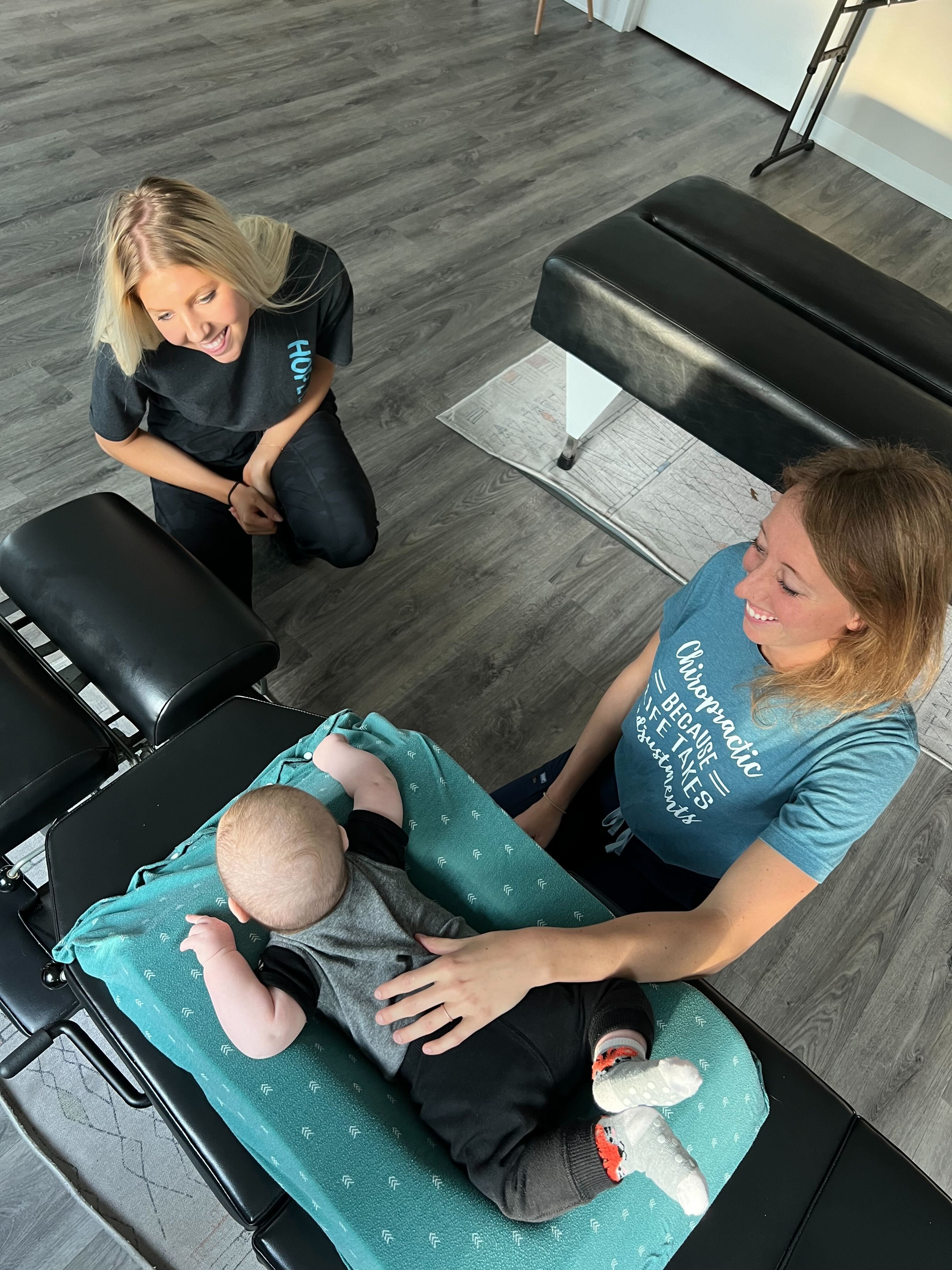Understanding Baby Chiropractic Care: More Than You Might Think
When most parents hear "baby chiropractic care," they might imagine tiny versions of adult adjustments—perhaps even picturing those dramatic twisting motions they've seen in movies. The reality is beautifully different. Pediatric chiropractic care is a gentle, specialized approach focused entirely on your baby's developing nervous system, using techniques so soft they often resemble a loving touch more than any medical procedure.
At its heart, baby chiropractic care is nervous system-based care designed to remove interference so your little one's body can function at its best. Think of it like clearing static from a radio signal—when the connection is clear, everything works as it should. Your baby's nervous system is the master control center, coordinating everything from breathing and digestion to sleep patterns and immune function. When this system operates without interference, your baby's natural healing abilities can flourish.
Why Babies Need Chiropractic Care
The journey into this world isn't always gentle for babies. Even the most natural births can create stress on a newborn's delicate spine and nervous system. Consider the incredible forces at work during delivery—the pushing, pulling, and twisting that helps bring your baby earthside. Add interventions like vacuum extraction, forceps, or even prolonged labor, and it becomes clear why some babies enter the world with their nervous systems already in a stressed state.
But birth trauma isn't the only concern. Those early developmental milestones—learning to hold their head up, rolling over, sitting, and eventually walking—all place new demands on your baby's spine and nervous system. Sometimes, these natural progressions can create areas of tension or restriction that affect how well your little one's body communicates with itself.
Many parents notice signs that their baby's nervous system might benefit from support: difficulty latching during breastfeeding, persistent colic, irregular sleep patterns, or seeming constantly uncomfortable. These challenges often stem from the same root cause—interference in the nervous system that prevents optimal function. Understanding these nervous system issues affecting children can help parents recognize when their baby might benefit from gentle chiropractic care.
How It Differs from Adult Care
Baby chiropractic care bears little resemblance to adult treatments. Where adult adjustments might involve more direct pressure or specific positioning, infant spinal care relies on incredibly gentle techniques—often using no more pressure than you'd use to check if a tomato is ripe. These specialized approaches respect your baby's developing spine and sensitive nervous system.
Pediatric chiropractors undergo extensive additional training to understand the unique needs of growing bodies. They know that a baby's spine has different proportions, their nervous system is still developing, and their response to care happens much more quickly than adults. The goal isn't to "crack" anything—it's to gently encourage the nervous system to shift from a stressed state to a more relaxed, healing-focused state.
This nervous system-based chiropractic approach recognizes that when interference is removed, babies often show remarkable improvements in their overall well-being. Parents frequently report better sleep, easier feeding, and calmer, more content babies—changes that reflect improved nervous system function rather than just symptom management.
The beauty of this gentle approach is that it supports your baby's natural development while addressing the root causes of discomfort. Research continues to show how chiropractic care can improve behavior in kids by supporting optimal nervous system function from the very beginning of life.
What Happens During Your Baby's First Chiropractic Visit
Walking into your baby's first chiropractic appointment can feel like stepping into uncharted territory. Many parents arrive with a mixture of hope and uncertainty, wondering what this gentle approach to healing might offer their little one. Understanding what happens during your baby's first chiropractic adjustment helps ease those natural concerns and sets realistic expectations for this important milestone in your family's wellness journey.
The beauty of pediatric chiropractic care lies in its thoughtful, unhurried approach. Unlike rushed medical appointments, your baby's first visit is designed to be comprehensive, comfortable, and completely centered around your family's unique needs and concerns.
The Initial Consultation - Comprehensive Health History
Your baby's first chiropractic visit begins long before any hands-on care takes place. The initial consultation serves as the foundation for everything that follows, creating a complete picture of your little one's health journey from conception to the present moment.
During this detailed conversation, we'll explore your pregnancy experience, discussing everything from prenatal stress and positioning to any complications that may have occurred. The birth story holds particular importance—whether your delivery was natural, involved interventions like forceps or vacuum extraction, or required a cesarean section. Each birth experience can impact your baby's nervous system function in different ways, and understanding these details helps us provide the most appropriate care.
We'll also discuss your current concerns, whether that's difficulty latching during breastfeeding, persistent crying, sleep challenges, or developmental milestones you're hoping to support. This conversation often reveals patterns that parents hadn't previously connected, helping us understand how your baby's nervous system might be responding to early life stresses.
The consultation extends beyond immediate concerns to include family health history, environmental factors, and your goals for your child's development. This comprehensive approach reflects our core values behind our family-centered approach, ensuring that every aspect of your baby's well-being is considered as we develop their care strategy.
Gentle Examination Process
The examination phase of your baby's first chiropractic visit might surprise you with its gentleness. Rather than the dramatic adjustments you might associate with adult chiropractic care, infant assessments rely primarily on careful observation and incredibly light touch—often no more pressure than you'd use to check if a tomato is ripe.
We begin by observing your baby's natural movements, posture, and responses. How do they hold their head? Do they favor turning to one side? Are their movements symmetrical? These observations provide valuable insights into nervous system function without causing any discomfort to your little one.
The hands-on examination involves gentle palpation along your baby's spine and neck, feeling for areas of tension or restricted movement. We're not looking for dramatic misalignments, but rather subtle patterns that might indicate nervous system stress. Your baby might be held in your arms during much of this process, maintaining their sense of security and comfort.

Throughout the examination, we're constantly assessing your baby's responses and comfort level. If your little one becomes fussy, we pause, allowing time for settling before continuing. This patient, responsive approach ensures that the examination itself becomes a positive experience rather than a source of additional stress.
The First Adjustment Experience
When it comes to your baby's first chiropractic adjustment, the experience often differs dramatically from what many parents expect. The actual adjustment techniques used for infants are extraordinarily gentle—so much so that babies frequently sleep through their entire treatment session.
The adjustment process begins with positioning your baby in the most comfortable way possible, often while you hold them or with them lying on a specially designed pediatric table. The techniques we use involve gentle finger pressure, light touches, and subtle movements that work with your baby's natural responses rather than forcing change.
You might notice that the "adjustment" looks more like a gentle massage or loving caress than any dramatic manipulation. This is intentional—babies' spines and nervous systems respond beautifully to these light touches, often releasing tension and improving function with minimal intervention.
During the adjustment, we're constantly monitoring your baby's responses, watching for signs of relaxation like deeper breathing, reduced muscle tension, or even falling asleep. Many parents are amazed to see their fussy baby become calm and content during this process, often experiencing their first peaceful moments in weeks.
The entire adjustment typically takes just a few minutes, though the appointment itself may last 30-45 minutes to allow for thorough consultation and examination. We never rush this process, understanding that building trust and ensuring comfort are essential for both you and your baby.
Following the adjustment, we'll discuss what you might expect in the coming days and weeks. Some babies show immediate improvements in sleep, feeding, or comfort levels, while others may need several visits before significant changes become apparent. This is where our personalized care plan approach becomes crucial, tailoring the frequency and type of care to your baby's specific needs and responses.
Your baby's first chiropractic visit represents the beginning of a journey toward optimal nervous system function and overall wellness. By understanding what to expect during this initial appointment, you can approach it with confidence, knowing that every aspect of the experience is designed with your baby's comfort, safety, and healing in mind. This gentle introduction to nervous system-based care often marks the start of transforming family health through comprehensive care, setting the foundation for your child's lifelong wellness journey.
Our Gentle Techniques: Designed Specifically for Little Ones
When it comes to pediatric chiropractic treatment, the techniques we use at Pinnacle Chiropractic are worlds apart from what you might envision for adult care. Many parents are surprised to learn just how incredibly gentle and precise infant adjustments truly are. Understanding these specialized approaches helps you feel confident about your baby's care and appreciate the thoughtful methodology behind every gentle touch.
The Pressure Difference - Why Baby Adjustments Use No More Pressure Than Checking a Tomato's Ripeness
The amount of pressure used during gentle chiropractic techniques for babies is genuinely minimal—comparable to the light touch you'd use when testing a tomato's ripeness at the grocery store. This isn't an exaggeration; it's the reality of how delicate and precise pediatric adjustments need to be.
Your baby's spine and nervous system are still developing, with soft cartilage that will eventually become bone. This means their bodies respond to incredibly light pressure—often just 2-5 pounds of gentle force. To put this in perspective, that's less pressure than you use when writing with a pencil or gently pressing your fingertip against your cheek.
This feather-light approach works because babies' systems are naturally more responsive than adults. Their nervous systems haven't yet developed the layers of compensation and tension that accumulate over years of life. A gentle fingertip adjustment that might seem almost imperceptible to an adult can create significant positive changes in your little one's nervous system function.
Specific Techniques We Use - Detailed Explanation of Gentle Methods
Our baby chiropractic adjustment process incorporates several specialized techniques designed specifically for infants. The primary method involves light fingertip pressure applied to specific points along your baby's spine and skull. These gentle contacts help restore proper nerve function without any twisting, popping, or forceful movements.
Soft tissue work forms another cornerstone of our approach. Using gentle massage-like motions, we help release tension in your baby's muscles and fascia. This is particularly beneficial for babies who experienced challenging births or spent extended time in cramped positions in the womb.
Cranial work represents one of our most delicate techniques. The bones of your baby's skull are designed to move slightly, and gentle pressure helps ensure these natural movements occur properly. This supports healthy brain development and can address issues related to feeding, sleeping, and overall comfort.
We also incorporate positional releases, where we simply help your baby's body find more comfortable, natural positions. Sometimes, just supporting your little one in a specific posture for a few minutes allows their nervous system to reset and function more effectively. This technique is especially helpful for addressing the effects of intrauterine constraint or birth trauma.
Reading Your Baby's Responses - How We Monitor Comfort Levels
Every baby communicates differently, and part of our expertise lies in reading these subtle cues throughout the adjustment process. We constantly monitor your little one's facial expressions, body language, and overall demeanor to ensure they remain comfortable and relaxed.
Positive responses often include deeper, more relaxed breathing, softening of facial features, and sometimes even falling asleep during the gentle work. Many babies actually seem to enjoy the process, often becoming calmer and more settled as we work.
If we notice any signs of discomfort—increased fussiness, tension, or crying—we immediately adjust our approach or take a break. Your baby's comfort is always our top priority, and we never push through resistance or distress.
We also pay attention to how your baby's body responds to our gentle touches. A spine that easily moves into better alignment tells us one story, while areas of restriction guide us to focus our attention differently. This real-time assessment ensures that each baby chiropractic adjustment process is truly individualized.
The techniques we use support healthy balance and coordination development in children and can help identify early indicators that might benefit from attention, including signs of scoliosis to watch for as your child grows.
Safety First: Your Questions About Newborn Chiropractic Care Answered
As a parent, your baby's safety is your top priority, and it's completely natural to have questions about newborn chiropractic care. Many families wonder, "Is chiropractic care safe for newborns?" and we understand these concerns. The truth is, when performed by properly trained professionals, pediatric chiropractic care is not only safe but can be incredibly beneficial for your little one's developing nervous system.
Is Chiropractic Safe for Newborns?
Research consistently supports the safety and effectiveness of chiropractic care for infants when delivered by qualified practitioners. A comprehensive review published in the Journal of Manipulative and Physiological Therapeutics found that adverse events in pediatric chiropractic care are extremely rare, with serious complications being virtually nonexistent when proper techniques are used.
The key difference lies in understanding that newborn chiropractic care bears no resemblance to adult adjustments. We use incredibly gentle pressure—often no more than the weight of a dime—to support your baby's nervous system function. Think of it like checking the ripeness of a tomato; that's the level of gentle touch we apply to your precious little one.
At Pinnacle Chiropractic, we follow strict safety protocols that include thorough health histories, gentle examination techniques, and careful observation of your baby's responses throughout the process. We never force or rush any aspect of care, always allowing your baby to guide the session and stopping immediately if they show any signs of discomfort.
Our Specialized Training
Not all chiropractors are trained to work with newborns, which is why seeking care from a pediatric specialist is crucial. Our team has completed extensive additional education beyond standard chiropractic training, including specialized coursework in prenatal and pediatric care, infant development, and nervous system function in growing children.
We maintain ongoing education requirements and stay current with the latest research in pediatric chiropractic care. This specialized training teaches us to recognize the unique needs of developing nervous systems and how to adapt our techniques accordingly. We understand that a newborn's spine and nervous system are still forming, requiring an entirely different approach than what we might use for older children or adults.
Our credentials include advanced certifications in pediatric and prenatal chiropractic techniques, ensuring that every family receives care from practitioners who truly understand the delicate nature of infant nervous systems and the gentle approaches required for optimal results.
When to Seek Care
Many parents wonder when their baby might benefit from nervous system support. Common signs include difficulty latching during breastfeeding, excessive fussiness or crying, sleep challenges, favoring one side when turning their head, or general tension patterns that developed during birth.
The birth process, while natural, can place significant stress on a baby's developing spine and nervous system. Whether your delivery was vaginal or cesarean, long or short, medicated or natural, your baby's nervous system may benefit from gentle support to help them transition into life outside the womb.
Early intervention often yields the best results, which is why many families who have received prenatal chiropractic care during pregnancy continue with newborn care. This approach supports the entire family's wellness journey and can be beautifully integrated with other supportive therapies when needed, creating a comprehensive approach to your child's development and health.
Remember, seeking chiropractic care for your newborn isn't about fixing something that's "broken"—it's about supporting their body's natural ability to function optimally from the very beginning of life.
The Beautiful Benefits: How Chiropractic Care Supports Your Baby's Development
As parents, we all want to give our babies the best possible start in life. While many families focus on nutrition, sleep routines, and developmental milestones, there's another crucial element that often goes overlooked: your baby's nervous system health. The benefits of chiropractic care for infants extend far beyond what most parents realize, creating a foundation for optimal development that can last a lifetime.
Nervous System Optimization - How Removing Interference Helps Your Baby's Body Function as Designed
Think of your baby's nervous system as the master control center—like a sophisticated computer network that coordinates every function in their tiny body. From breathing and digestion to sleep patterns and immune responses, everything depends on clear communication between the brain and body. When there's interference in this system, it's like having a dimmer switch turned down instead of a bright, clear connection.
Baby chiropractic care focuses on identifying and gently removing this interference, allowing your little one's nervous system to function exactly as nature intended. The birth process, even under the best circumstances, can create tension and misalignments that affect how well your baby's body communicates with itself. By addressing these issues early, we're essentially helping your baby's internal "computer system" run more efficiently.
This nervous system optimization is particularly important during your baby's first year, when rapid brain development and neural pathway formation are occurring at an incredible pace. When the nervous system functions optimally, your baby's body can better adapt to their new environment outside the womb, supporting everything from their stress response to their ability to process sensory information.
Common Improvements Parents Notice
The real impact of nervous system-based care becomes beautifully evident in the day-to-day changes parents observe. Many families report remarkable improvements in their baby's overall well-being within just a few gentle adjustments.
Sleep improvements are often the first change parents notice. Babies who previously struggled with short naps or frequent night wakings often begin sleeping for longer, more restful periods. This happens because a properly functioning nervous system can more easily shift from the active "gas pedal" mode to the calm "brake pedal" mode needed for quality sleep.
Feeding becomes easier and more enjoyable for both baby and parent. When spinal tension is reduced, babies often latch better, experience less reflux, and show improved coordination during nursing or bottle feeding. Many parents are amazed at how much more content their little ones become during and after meals.
Digestive improvements frequently follow, with reduced colic symptoms, less gas discomfort, and more regular bowel movements. The connection between spinal health and digestive function is particularly strong in infants, as the nerves controlling digestion can be significantly impacted by even minor spinal tensions.
Perhaps most importantly, parents often describe their babies as simply being "happier" and more content. Reduced fussiness, longer periods of calm alertness, and an overall sense that their baby is more comfortable in their own body are common observations.
Long-term Developmental Support
The benefits of infant spinal care extend far beyond those early months, creating a foundation for healthy development that supports your child as they grow. Early nervous system care helps establish optimal neural pathways that influence everything from motor development to emotional regulation.
As your baby grows into a toddler and beyond, this foundation becomes even more valuable. Children who receive early chiropractic care often demonstrate better body awareness, coordination, and balance as they learn to crawl, walk, and explore their world. The how chiropractic helps with behavior improvements becomes increasingly apparent as children develop better self-regulation skills and emotional resilience.
This early investment in nervous system health also supports your child's ability to handle future physical and emotional stresses. Whether it's learning to ride a bike, starting school, or navigating the various challenges of childhood, a well-functioning nervous system provides the foundation for adaptability and resilience.
Additionally, establishing healthy habits early—including proper spinal health and supporting your child's natural hydration and focus—creates patterns that benefit your child throughout their life. At Pinnacle Chiropractic, we've witnessed countless families whose early investment in pediatric chiropractic treatment has supported not just immediate comfort, but long-term health and development that extends well into the teenage years and beyond.
Preparing for Your Visit: Making the Experience Smooth for Everyone
Walking into a chiropractic office for your baby's first adjustment can feel overwhelming, but with a little preparation, you can create a calm, positive experience for your entire family. The key is understanding what to bring, when to schedule your visit, and how to set realistic expectations for the journey ahead.
What to Bring for Your Baby's First Adjustment.
Pack your diaper bag with all the usual essentials—diapers, wipes, a change of clothes, and your baby's favorite comfort items like a pacifier or small blanket. These familiar objects help create a sense of security in a new environment. Don't forget to bring your baby's health records, including birth details, any previous medical evaluations, and a list of current concerns you'd like to discuss.
Many parents find it helpful to write down their questions beforehand. Whether you're curious about feeding difficulties, sleep patterns, or developmental milestones, having these thoughts organized ensures you won't forget important details during your visit. Remember, this appointment is about understanding your baby's unique needs and developing personalized care plan development that supports their optimal development.
Timing Your Visit - Best Times of Day and Feeding Schedules to Consider
The timing of your baby's first chiropractic visit can significantly impact how smoothly the appointment goes. Schedule your visit when your baby is typically most alert and content—usually mid-morning or early afternoon for most infants. Avoid scheduling during usual nap times or when your baby tends to be fussy.
Consider your feeding schedule carefully. A hungry baby will be more irritable, but an overly full baby might be uncomfortable during the gentle examination. Aim to feed your baby about 30-45 minutes before the appointment, allowing enough time for digestion while ensuring they're not hungry during the visit.
If you're breastfeeding, don't worry about feeding during the appointment if needed. Pediatric chiropractors understand that babies have their own schedules, and our family-centered approach to healing means accommodating your family's needs throughout the process.
What Happens After - Post-Adjustment Care Recommendations and Follow-Up Planning
After your baby's first adjustment, you might notice immediate changes or subtle shifts over the following days. Some babies sleep more soundly that night, while others may seem more alert and content. Every baby responds differently, and these variations are completely normal as their nervous system begins to function more optimally.
Your chiropractor will provide specific post-adjustment care recommendations tailored to your baby's needs. This might include gentle stretches, positioning suggestions during sleep and feeding, or simple activities that support the adjustment's benefits. These recommendations aren't complicated—they're designed to integrate seamlessly into your daily routine.
Follow-up planning is crucial for maintaining the progress achieved during your baby's first chiropractic visit. Your care team will discuss the recommended frequency of visits based on your baby's specific needs and response to care. Some families benefit from weekly visits initially, while others may need more or less frequent appointments. The goal is creating a sustainable care plan that supports your baby's developing nervous system while fitting comfortably into your family's lifestyle.









